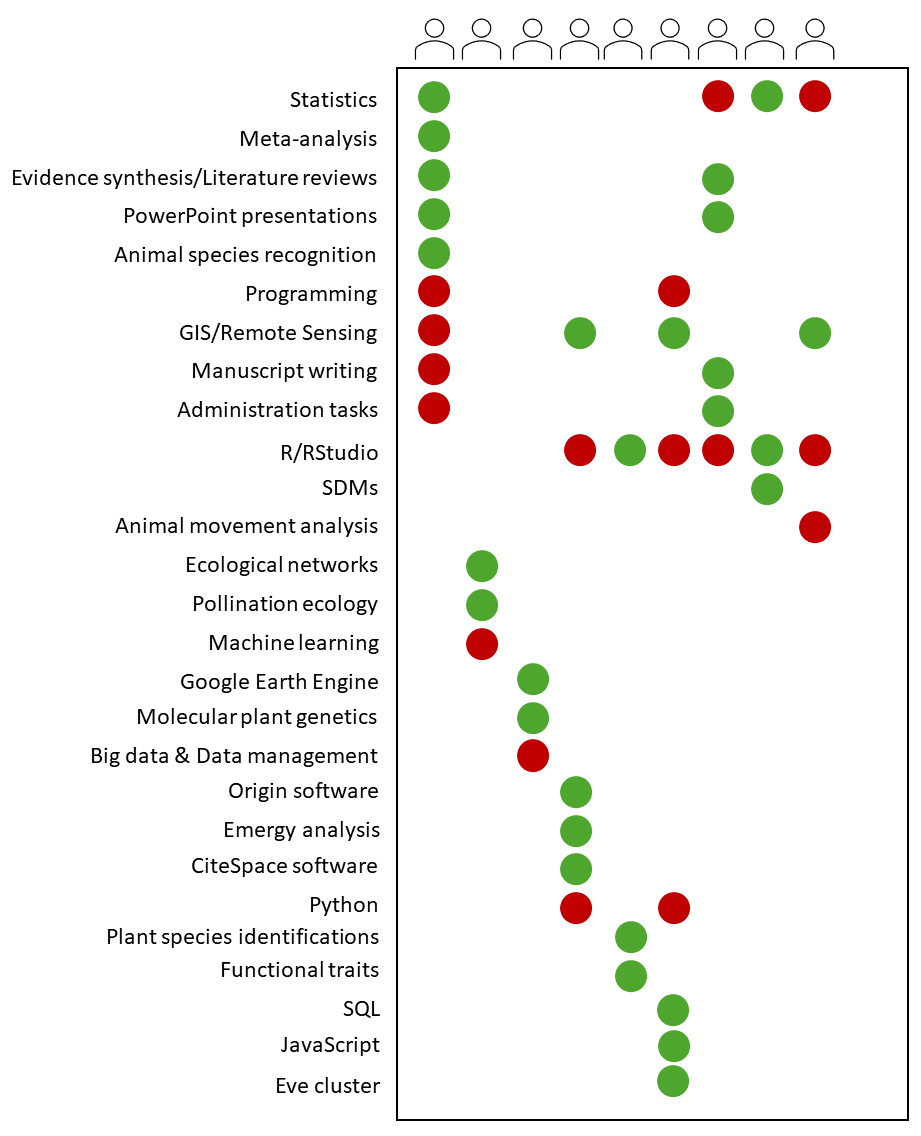Research group
BIOECOS
(BIOdiversity & ECOsystem Services)
News
November 2025: Congratulations to Elizaveta Shcherbinina for receiving the Sustainability Award last week! A well-deserved recognition of her dedication and impact during her Bachelor studies in the University of Tübingen.
October 2025: Jannatul Ferdous and Elina Takola participated at the joint Graduate Meeting of the Animal Behaviour Section of the German Zoological Society (DZG) and the Ethological Society (Ethologische Gesellschaft e.V.). Congratulations to both!
September 2025: The BIOECOS group took part in the retreat of the Department of Computational Landscape Ecology in Eisenach. It was a very productive retreat and we had the chance to strengthen our relationships with the rest of the Department.
August 2025: Come join us at the CLE summer party on the 12th of August!
July 2025: Johanna Esguerra submitted her first author paper about the movement ecology of the northern lapwing! A pre-print is available here. Congratulations, Johanna!
June 2025: Elina Takola taught the course "Modelling species-habitat relationships across scales for nature conservation" at the Martin Luther University of Halle-Wittenberg.
May 2025: Leslie Resch (University of Leipzig) joined the group for her Master thesis on the drivers of insect population dynamics. Welcome, Leslie!
April 2025: Jannatul Ferdous is back in the group for her Master thesis on individual-based modelling of agricultural bird movement. Welcome back, Jannatul!
March 2025: The decimatoR R package is a tool created by former research assistant in our group, Elizaveta Shcherbinina. This package facilitates the homogenization of coordinates from different sources. The software publication is available in Zenodo and GitHub. Congratulations, Elizaveta!
February 2025: Elina Takola was part of a broad collaboration of >300 scientists around the world. The project examined how the choice of different statistical models influences the results of an analysis. A publication with the title "Same data, different analysts: variation in effect sizes due to analytical decisions in ecology and evolutionary biology" is now published in the journal BMC Biology! Congratulations Elina!
January 2025: Our group has two new preprints online! Maximus Anochirim is leading the manuscript "The implementation of network meta-analysis in Ecology; a case study using crop yield data", where he showcases a new statistical method (i.e. network meta-analysis), borrowed by Medical Sciences. To our knowledge, this is one of the first implementations of network meta-analyses in Ecology. Congratulations Maximus! Moreover, Elina Takola is leading the manuscript "Does sustainable agriculture promote biodiversity and yield? A second-order meta-analysis". This is a broad quantitative synthesis of literature, aiming at exploring the relationship between biodiversity and productivity in croplands, grasslands and agroforestry systems. Congratulations Elina!
December 2024: Maximus Anochirim is participating in the annual meeting of the British Ecological Society in Liverpool with his project about implementing network meta-analyses in experimental ecological data.
December 2024: Our group is now on LinkedIn. Let's connect!
November 2024: We welcome Jannatul Ferdous to our group!
October 2024: Members of our group are participating in the annual conference of SORTEE (Society for Open, Reliable and Transparent Ecology and Evolutionary biology).
October 2024: We welcome Johanna Esguerra, Hayder Ramos Guerra and Olga Kuznetsova to our group!
October 2024: Today we had a farewell gathering for Dr. Michael Beckmann, who was the group leader of BIOECOS for the last few years. We are thankful to Micha for his important contribution and hard work. We wish him all the best for his new position!
September 2024: We welcome back Elizaveta Shcherbinina to our group! Elizaveta did her internship with us in the past and now she is re-joining as a student helper.
August 2024: Elina Takola is participating in the annual conference of the Ecological Society of America.
June 2024: We welcome back Maximus Anochirim to our group! Maximus did his internship with us in the past and now he is re-joining as a research assistant.
Our research focuses on monitoring, mapping and modeling spatio-temporal patterns of biodiversity and ecosystem services. It comprises conceptual work, syntheses and development of methods. The main research questions on which we focus are:
- Q1:How does landscape structure affect insect population trends?
- Q2: A) Which agricultural management practices lead to win-win outcomes for biodiversity and yield? B) How can the yield treatments be ranked based on their effectiveness?
- Q3:How does landscape fragmentation affects the fitness of agricultural birds?
- Q4: How does the structure of the surrounding landscape affect the productivity of agricultural crops?
Our aims are:
- Understanding relationships between biodiversity, landscape features, and land use intensity
- Developing and using methods that aggregate data from multiple studies / sites to extract broader patterns
- Synthesis of ecosystem services: Trade‑offs, synergies, and multi-functionality
- Promote excellence and innovation in research through open science frameworks
- Foster a more transparent, inclusive, and effective research ecosystem by implementing open science practices
Skills of BIOECOS group members

Contact
Dr. Elina Takola (Group leader) email
Projects
Current Projects
- FLARE - Future Lapwing Responses to Expansions: Model the movement behaviour of northern lapwings (Vanellus vanellus) in an agricultural landscape.
- BESTMAP - Behavioural, Ecological and Socio-economic Tools for Modelling Agricultural Policy; Horizon 2020 project funded by the European Commission more information
- WAKANAKA: Ermittlung naturschutzbezogener Kriterien in der Umweltprüfung der Bedarfsplanung für Stromnetze und in der Bundesfachplanung zur Erhöhung der Planungssicherheit und Verhinderung von Zielkonflikten
- ECOPOTENTIAL: improving future ecosystem benefits through earth observations
- TALE - Towards multifunctional agricultural landscapes in Europe: Assessing and governing synergies between food production, biodiversity and ecosystem services
Members
Jannatul Ferdous
Leslie Resch
Johanna Esguerra
Elizaveta Shcherbinina
Johannes Dittmann
Dr. Michael Beckmann (previous group leader, 2011-2024)
Dr. Tuanjit Sritongchuay (2021-2025)
Can Zhang (2022-2024)
Julián Equihua (2021-2024)
Maximus Anochirim (01.06.2024-31.12.2024)
Olga Kuznetsova (01.09.2024-31.12.2024)
Anne Paulus (2018 - 2024)
Elizaveta Shcherbinina (01.05.2024-31.07.2024)
Sangita Chouhan (01.04.2024-31.07.2024)
Camilla Geiger (01.09.2023-31.12.2023)
Sontje Nier (05.06.2023-14.07.2023)
Tobias Richter (27.02.2023-11.04.2023)
Recent publications
For more information on publications, please visit the personal websites of our members.
